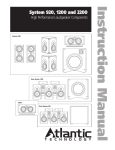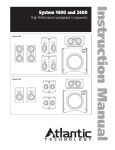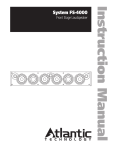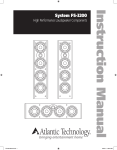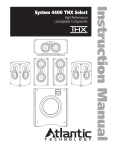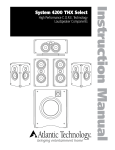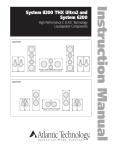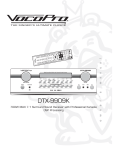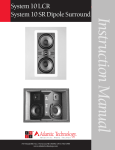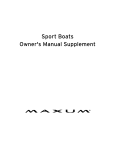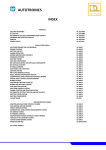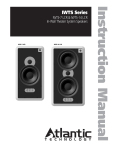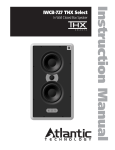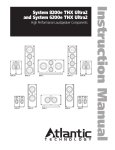Download Atlantic Technology FS-5000 Instruction manual
Transcript
Front Stage Loudspeakers FS-4000 FS-5000 Instruction Manual FS-4000 and FS-5000 Table of Contents Front Stage Loudspeakers Table of Contents 2 Unpacking the Speaker 2 Attaching the Grille 3 Description 3 3 Model FS-4000 and FS-5000 Front Stage Loudspeaker Acoustic Controls 4 5 Speaker Placement and Home Theater Assembling the Speakers 4 Placement 6 System Setup 6 6 6 7 8 8 Using the Rear Panel Controls System Setup When Using an Optional Subwoofer System Setup Without a Subwoofer Speaker Placement — Optional Surround and Subwoofer Using Surround Speakers Setting Levels 9 System Wiring 8 Connecting Your System 10 Care of Your Speakers 11 Specifications FS-4000 and FS-5000 Front Stage Loudspeaker Thank you for choosing Atlantic Technology products. Your new speakers are precision-crafted to give you years of enjoyable, trouble-free service. This manual covers the Atlantic Technology System FS-4000 and FS-5000 speakers. It will show you how to incorporate these speakers into your present setup, as well as how to assemble a complete system from them. These systems can be used with all current and past sound formats including Stereo, Dolby Surround®, Pro Logic®, Dolby Digital 5.1®, Dolby Digital EX®, DTS®, DTS ES®, DTS ES Discrete®, DTS Neo:6®, DVD-Audio and SACD Audio. IMPORTANT: Although it may seem like asking for driving directions, please take a few moments to read all of this booklet. It has many helpful tips and ideas on properly setting up and using your system. We promise that if you take the time to read and follow these tips you’ll get better system performance and more enjoyment. Unpacking the Speaker Use care when unpacking the speakers. Remember to keep the original boxes and packing material, in the unlikely event the speakers need servicing, or if you move. Attaching the Grille The included metal grilles are held to the front of the enclosures with powerful neodymium magnets. There are depressions on the back of the grille that the magnets fit into. Once the speakers are in their final position. Position the grille over the magnets on the baffle. Move them together slowly and when you get close enough, the magnets will draw the grille in and hold it tight. Be careful not to get your fingers caught between the grille and the cabinet. For Future Reference Record the serial number and date of purchase of the speaker here. The serial number is found on the speaker terminal panel on the back of the enclosure. Serial Number Date of Purchase The contents of this manual are Copyright © 2006 by Atlantic Technology International, Corp., and may not be duplicated or reproduced by any means, whether physical, electronic or otherwise without prior written consent from Atlantic Technology International, Corp. Atlantic Technology and the Atlantic Technology logo are registered trademarks of Atlantic Technology International, Corp. Specifications are those in effect at the time of printing.Atlantic Technology International, Corp. reserves the right to change specifications or designs at any time without notice without obligation to modify existing units. Individual Component Descriptions Instruction Manual Description Model FS-4000 and FS-5000 Front Stage Loudspeakers The Front Stage Loudspeakers are integrated high-performance loudspeakers containing all three front channel speakers (LCR) in a single elegant, slim enclosure. These speakers can be either wall-mounted above or below the video display, or can be placed on a shelf or on the television itself with the included rocker base. These units are intended for use with the latest generation of flat screen video displays. The advanced design of these speakers delivers detailed, articulate sound for a dramatic viewing experience. Each of the three separate internal chambers contains a complete speaker system. In the FS4000, each speaker is comprised of one 4 ½-inch (115mm) GLH (Graphite Loaded Homopolymer) woofer, one 4 ½-inch (115mm) GLH Pressure Driver, and an advanced 1-inch (25mm) ferrofluid-cooled, damped softdome tweeter. The drivers are mounted in an acoustically inert, heavily braced MDF enclosure and are magnetically shielded so they may be placed close to any type of video monitor without concern of video interference. Note also that the tweeters are mounted above the centerline of the woofers. This arrangement results in a smoother in-room frequency response, for greater clarity and detail. For accurate reproduction of a multi-channel soundtrack, the three frontchannel speakers must have the same essential tonal balance. Since the Front Stage Loudspeakers are comprised of three identical speakers mounted in a common enclosure, they deliver an exceptionally smooth and coherent sonic signature across the front soundstage. Acoustic Controls System FS-4000 and FS-5000 include unique acoustic controls to help maximize their performance in your room. These controls are explained in greater detail on page 6. In the FS-5000, each speaker utilizes two high-power 4 ½-inch GLH woofers and the 1-inch (25mm) soft-dome tweeter. Figure 1 FS-4000 FS-5000 Placement Front Stage Loudspeakers Placement Figure 2 Speaker Placement Speaker Placement and Home Theater Remember that the primary goal of a good home theater is not to make you believe that you are in a movie theater. It’s to make you believe you’re in the movie. For a home theater system, place the speaker either above or below your flat screen display, centered horizontally. See Figure 2. The speaker comes with your choice of two wall-mount brackets, a Straight Bracket that points the speaker straight ahead, and an Angle Bracket that either points the speaker down at the listeners (if it’s mounted above the display) or up at the listeners (if it’s mounted below the display). See Figure 6. In addition, the speaker can also be used as a set-top or shelf-mounted speaker. Should you choose to use it that way, we’ve included Atlantic’s exclusive Rocker Base. This base attaches easily to the bottom of the speaker so that it may be tilted up or down towards the listening area as needed. Alternately, the speaker can be placed directly on a shelf or on the television without the rocker base, if desired. Four self-adhesive rubber feet are included to prevent vibration and protect the mounting surface. !BOVE OR "ELOW &RONT3PEAKERSHOULDBE PLACEDASCLOSETOEARLEVELAS POSSIBLE7HENUSEDINANONWALL APPLICATIONTHEBOUNDARY COMPENSATIONSWITCHESSHOULDBEON See Figure 9 on Page 5 to attach the Rocker Base You may also simply mount the speaker to the wall using the built-in keyhole brackets. Because of the high quality components used, the speaker is very heavy for its size and care must be used when hanging it. Be sure to use a strong screw to drive into the wall, one whose head and shaft will fit properly within the keyhole opening and slot. Also be sure to drive the screw directly into a stud or to use a mounting device (such a molly-bolt) that is capable of safely holding the speaker’s weight. Never simply drive a nail or screw into sheet rock or other wall materials, as this mounting method may not be sufficient to safely support the weight of the speaker. Plastic wall anchors are not recommended NOTE: Always consult a knowledgeable installer regarding the proper mounting hardware to use with your speakers. See Figures 3-9 for mounting instructions Figure 3 Stud Bracket Removal For shipping purposes the stud bracket is mounted to the speaker. Remove the stud bracket by removing the screws before attempting any installation. Reserve the screws for attaching Straight/Angle Brackets in Figure 6. Figure 4 Stud Bracket ST Assembling the Speakers STUD Figure 5 Stud Bracket installation Screw stud bracket through drywall into stud through aligning holes on bracket as shown. STUD Assembling the Speaker STUD ST Instruction Manual Install so prong points out and DOWN. Hang speaker on the prong by inserting prong through the keyholes directly on rear of speaker or on the Straight/Angle Brackets. Close up view Side view Figure 6 Straight/Angle Bracket installation Mount the brackets to the speaker with the included short machine screws Double Keyhole for flush mounting Figure 8 Angle Bracket Figure 7 Straight Bracket Make sure the closed side of the brackets are facing the ends of the speaker Figure 9 Rocker installation Mount the rocker to the bottom of the speaker with the included short machine screws System Setup Front Stage Loudspeakers System Setup System Setup When Using an Optional Subwoofer Figure 10 Some older surround sound decoders and receivers offer a choice of “Normal” or “Wide-band” modes for the center channel speaker. The Front Stage Loudspeakers are designed to be used in the Normal mode. Modern digital processing multi-channel systems provide a Bass Management menu, which typically requires you to select between “Small” or “Large” speakers during system set-up. When using this speaker with a dedicated subwoofer, please set all the speakers on the receiver’s set-up menu to Small. Many of the newer surround receivers and processors give you a choice of subwoofer-to-satellite crossover frequency. If yours does, we recommend that you start with a setting of around 80Hz for the smoothest blend between the subwoofer and the Front Stage Loudspeaker. System Setup Without a Subwoofer Using the Rear Panel Controls HF Energy This control changes the tilt or rolloff slope of the tweeter in order to compensate for varying room acoustics. Use the Average position for rooms with a reasonably balanced combination of hard reflective surfaces (sliding glass doors and bare walls) and soft absorptive surfaces (thick carpeted floors and overstuffed furniture). The Reverberant position is meant for rooms with an abundance of hard surfaces, while the Damped Room setting raises the tweeter’s output to counteract the effect of an overly absorptive, acoustically “dead” room. Putting this switch to the “On” position adjusts the lower frequency output to compensate for the typical sound colorations caused by placing the speaker very close to a large surface, such as a TV screen, a wall, or on a shelf in an enclosed entertainment unit. If your speaker is mounted as described above, you may prefer its sound when the Boundary Compensation controls are engaged. Conversely, if it is free-standing, away from large surfaces (such as when the speaker is placed on a stand shelf, away from other large surfaces), you may prefer the sound with the position in the “Normal” position. Boundary Compensation In all cases, we recommend you try both switches in their various positions and use the settings that sound best in your particular room. Note that the settings of the Left, Center, and Right speakers may differ from each other. For some listeners, a full home theater setup with a separate subwoofer and rear surround speakers may not be feasible or desired. In that case, the Front Stage Loudspeaker will provide high quality sound all by itself—far better than the small speakers built into most televisions. In those situations, we recommend you set your surround sound receiver’s set-up menu to “Subwoofer—No,” and “Surround Speakers—Off.” Set this way, most receivers will blend some of the rear channel surround information into the front channels, giving a more spacious sound. Advanced user setup: For even better results, if your surround receiver has an adjustable subwoofer crossover frequency, select “Subwoofer—Yes” (even though you are not using a subwoofer) and adjust the subwoofer lowpass control to 60Hz. That way, all the bass from 60Hz and above will be sent to the Front Stage Loudspeaker, which will result in a full-bodied, credibly full-range sound to be reproduced, while at the same time, preventing the very low bass signals (below 60Hz) from overdriving the receiver’s amplifier section at high output levels. System Setup Instruction Manual Speaker Placement — Optional Surround and Subwoofer /PTIONAL$IPOLE"IPOLE 3PEAKERSSHOULDBE PLACEDDIRECTLYTOTHE SIDESOFTHESEATINGAREA ANDAPPROXIMATELY FEETMETER ABOVETHELISTENERSEAR LEVEL ,EFT 3URROUND &3OR&3 /PTIONAL 3UBWOOFER ,EFT 32 2IGHT 32 /PTIONAL$IRECT2ADIATOR3PEAKERS IFUSEDSHOULDBEPLACEDSLIGHTLYBEHIND THELISTENINGPOSITIONANDSAMEHEIGHTAS DIPOLEBIPOLESOR,2SARE APPROPRIATE ,EFT 3URROUND "ACK 2IGHT 3URROUND "ACK /PTIONAL3URROUND"ACK3PEAKERS SHOULDBEPLACEDAPPROXIMATELY FEETMETERABOVETHELISTENERS EARLEVELANDOFFTHECENTERAXIS $IRECTRADIATORSOR ,2SMAYBEUSEDHERE 2IGHT 3URROUND System Setup Front Stage Loudspeakers Using Optional Surround Speakers Connecting Your System If you are setting up a full home theater system, any of our surround speakers, boxed or in-wall, will work very well with the Front Stage Loudspeakers. All Atlantic Technology speakers are “voiced” to the same standards of tonal neutrality and sonic accuracy. Our model 2200SR Bipole/Dipole surround speakers, for example, would be an excellent match for an FS-based home theater system. Begin with the side speakers set to “Dipole,” then experiment with the Bipole/Dipole switch to obtain the most pleasing and realistic effect in your listening room. We recommend that you connect your system using high quality dual conductor stranded wire of 16 gauge or heavier, for lengths up to 25 feet (8m) . Remember, the lower the gauge number, the heavier the wire. Use heavier gauge wire for longer runs. Please contact your audio/video dealer or installer for specific cable recommendations and further information regarding special circumstances. The terminals themselves are designed to allow the use of very heavy speaker wire or connectors. Be sure to tighten them securely, but don’t over-tighten them. See your Atlantic dealer or visit our website (www.atlantictechnology.com) for more information. The best location for surround speakers is straight out to the sides, or slightly behind the primary listening area, approximately 1-2 feet (.3-.6m) above seated ear level, but no closer than 2 feet (.6m) from the ceiling (see previous page). The surround speakers are primarily intended to re-create the ambient sounds taking place in the movie scene. Therefore, throughout most of a movie or TV program you may not be consciously aware of output from these speakers. In other words, don’t worry if you aren’t hearing the surround speakers. Please try to avoid the trap of turning the surrounds up and up so that you hear them most of the time. The result will be a much less believable surround experience. Setting Levels When setting up a complete home theater we strongly recommend that you use a Sound Pressure Level (SPL) meter. As of this writing Radio Shack® has one that’s affordably priced (approximately $40-$60) that can be used effectively. To use this meter, turn on your system, put the processor/receiver in Test Mode and set its main volume control somewhere between -20 dB and 0dB (or a reasonably loud level in your listening room). Sit in the prime listening position, set the SPL meter to the 70dB scale, slow response, and C weighting. Hold the meter with the microphone pointed up towards the ceiling and in front of you. Cycle the test tone from speaker to speaker, setting each to the same level (usually75dB) using the individual level settings available in the processor/receiver (please see the instructions for your processor/receiver if you are unsure of how to access the test signal or level controls). IMPORTANT NOTE: The power recommendation for these speaker systems assumes that you will not operate your amplifier/receiver in a way that produces distortion. Even rugged speakers like these can be damaged by an amplifier driven into audible distortion. The harsh amplifier distortion (“clipping”) that occurs in this situation will eventually cause damage to the speaker system. This type of damage may be cumulative and can build up over time, as the amplifier is driven into overload again and again. Such damage is easily identifiable through examination of the damaged speaker’s voice coil and is not covered by the warranty. These systems will play very loudly when provided with enough undistorted power to do so. If necessary, consult your dealer or Atlantic Technology for additional information. WARNING: To prevent risk of electrical shock or damage to your equipment, always switch off the amplifier or receiver when making any system connections. You can connect your speakers by using a variety of audio connectors such as banana plugs, pin connectors, spade lugs, etc., or you can: 1. Remove ½” (13mm) of insulation from each wire end. 2. Twist the stranded wire together, keeping the two ends separate. 3. Place the appropriate wire through the postholes in the connectors. These holes are revealed when you loosen the connector’s capscrew. 4. Tighten down the capscrew tightly, but be careful not to over tighten it. 5. Check the tightness of the capscrews 24 hours after hookup and occasionally after that, as they can loosen over time. We recommend that you check your local electrical codes to make sure that you are not using improper connectors. It’s important to observe polarity while making speaker connections: red (+) terminals on the amplifier to red (+) on the speaker, black (–) on the amplifier to black (–) on the speaker. Look carefully at the wires you are using and note that one of the conductors of each pair will typically be identified by color printing on the outer jacket, ridges on the outer jacket, or a thread intertwined with the wire strands. By convention, the marked wire is connected to the red (+) terminal. Whether you are connecting a complete system, or adding a single speaker component to your present system, the wiring should look like the system wiring diagrams on the opposite page. WARNING: Before turning on the amplifier, be certain that no stray wire strands are touching across any terminals as this might damage your amplifier. Finally, check the polarity of your front speakers by listening to some stereo music with good bass content. If the sound seems “hollow”, unusually spread out, or seem to have weak bass, recheck your connections for proper polarity and correct any out of phase connections by reversing the connections to one speaker only, if necessary. System Wiring Instruction Manual System Wiring Be sure to connect red (+) on the speaker to red (+) on the amplifier and black (–) on the speaker to black (–) on the amplifier. Rear of Surround Sound Processor LEFT RIGHT SURROUND SURROUND LEFT CENTER RIGHT Optional Surround Speakers 10 Care of Your Speakers Front Stage Loudspeakers Care of Your Speakers Clean your cabinets using a soft, lint-free cloth. If you wish, you can slightly moisten the cloth with plain water. Do not use any other cleaning agents or chemicals. Be careful not to get any water on the driver cones or tweeter domes. After carefully removing the grilles from the speakers by pulling them forward, gently clean them with a quick pass from a vacuum cleaner with a brush attachment. This should remove any dust accumulation. Reattach them by lining up the magnet depressions in the back of the grilles with the magnets on the speaker baffle and slowly moving them closer until they connect with each other. Avoid placing your speakers in direct sunlight or near a source of heat that may, over time, damage the finish. IMPORTANT: SAVE YOUR BOXES! If you can do so, save the cartons, packing pieces, and plastic bags that came with your speakers. They will be useful in case you move or have to ship your loudspeakers for any reason. In any case, save all packing materials until you are certain that the systems have suffered no damage in shipment. If you find such damage, either visible or internal, contact your dealer immediately. Specifications Instruction Manual Specifications Model FS-4000 Type 2-way with Bass Pressure Drivers FS-5000 2-way with dual woofers Drivers Woofer Pressure Drivers Tweeter (3) 4 ½” (115mm) GLH (3) 4 ½” (115mm) GLH§ (3) 1" (25mm) soft dome (6) 4 ½” (115mm) GLH§ Frequency Response 75Hz – 20kHz ±3dB 70Hz – 20kHz ±3dB Nominal Impedance 6 Ohms 6 Ohms § (3) 1" (25mm) soft dome Crossover Frequency 3.75kHz, 3rd order 3.75kHz, 3rd order Sensitivity 89dB 89dB Recommended Amplifier Power 10 – 125 Watts RMS 10 – 150 Watts RMS Magnetic Shielding Yes Yes Dimensions w/ grilles (W x H x D)* 39¾ x 6 ½ x 5½" 1010 x 165 x 140mm 50 x 6 ½ x 5½" 1270 x 165 x 140mm Weight (ea) 27lbs; 12.3kg 36lbs; 17kg Graphite Loaded Homopolymer § *Height without base. Add 1 1⁄8" (28mm) height for base. Specifications are those in effect at the time of printing. Atlantic Technology reserves the right to change specifications or appearance at any time without notice. Dolby Digital, 5.1, Dolby Stereo and Dolby Pro Logic are trademarks of Dolby Laboratories Licensing Corporation. DTS is a registered trademark of DTS Technology. 11 343 Vanderbilt Avenue Norwood, MA 02062 (781) 762-6300 www.atlantictechnology.com 015-1401












